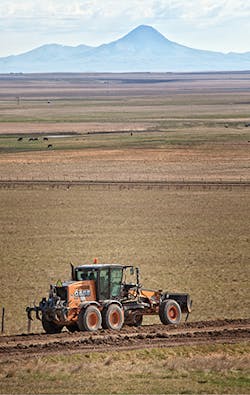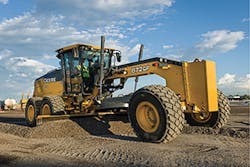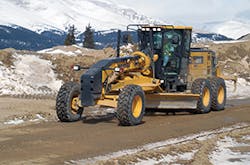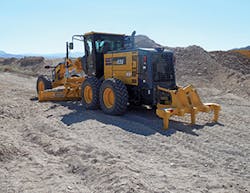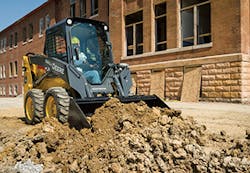When you look around a job site at a group of equipment operators, usually it’s pretty easy to pick out the people who drive the motor graders…they’re the guys with the salt-and-pepper hair. Why? Because their machine requires more experience and finesse than most anything else on the lot.
“The first time I climbed into the cab of one of these beasts nearly 20 years ago, I took one look at the clump of levers, and wondered why there were so many and how anyone could possibly learn all there was to know in making them work together,” says Luke Kurth, motor grader marketing manager for John Deere. “Learning to work all of the controls is just the start of the process. The tough part is understanding the machine, its feel, and putting it in the right position to do what it can do.”
That’s what makes his company’s G/GP series (670/770/870) machines the most productive ever. “In a reasonably short time, muscle memory allows the operator to control the machine, but that’s just where the real learning starts,” he says. “Getting a feel for the entire site and anticipating such things as bumps and different materials, that’s what takes time.” After a pause, he finishes his thought, “Some people never master it.”
Ron McMahon, Motor Grader Specialist at Komatsu, agrees, adding that it takes a lot more than muscle memory to get the machine to perform as you want it to. McMahon has been working with Komatsu and its motor graders since 2001, recalling his first impressions of operating conditions that in comparison with today’s GD655-6 left much to be desired.
“Over the years, things have really changed,” he says, pointing to significant improvements in visibility (“You can see both sides of the mold board as well as the ripper”), noise (“With the Tier 4 Final engine, the sound level is 74 dB, less than OSHA’s standard for use of hearing protection”), comfort (“an air suspension seat and overpressure air to keep dust our of the cab”), and easy-to-operate electronic controls.
The John Deere 872GP
According to John Bauer, brand marketing manager at CASE Construction Equipment, back when he got started, motor graders were not as operator-friendly as they are today. “In the past, motor graders were primarily used for fine-grading after bulldozers and other equipment had done all the rough-grading on a project,” he explains. “They were traditionally used in road construction and maintenance, but recent advancements in motor grader technology have made these machines much more versatile.”
Today’s B-series (845B, 865B, 865B AWD, 885B, and 885B AWD) “offer huge advantages in performance and economy that are truly amazing.”
“We’ve seen continuous improvements to the iron making the machines stronger and better balanced,” says Wade Porter, Caterpillar’s Motor Grader Product Application Specialist. “But, it’s advancements in technology that have brought our M3 machines to where they are today”—a vision shared by all—and that’s where we’re going next, starting with performance.
Putting the Power to the Ground
Face it, nothing happens until you can do this efficiently, which is why all the manufacturers spend so much time and effort on their powertrains, starting with their engines and carrying right on through to the wheels via their transmissions that along with Tier 4 Final powerplants the most sophisticated systems in the process.
The advancements Caterpillar’s Porter has in mind with 14-, 16-, and 18-M3-series machines involve such things as more power and fuel efficiency from the Cat C13 ACERT engine, the flexibility and maximum productivity of the 8F/6R power-shift transmission, and Cat Advanced Productivity Electronic Control Strategy with intelligent software that maintains consistent torque and smooths out shift points. The roll-call of new and/or improved features such as machine control and Product Link and Vision Link telematics systems “make today’s machines more productive and operator-friendly than ever,” explains Porter.
“Our new machines are a little larger and heavier, but the transmission adds to productivity using the torque converter for precision work where the transmission swaps automatically to keep the engine from stalling so you can continue to work, even when you run into an immovable object,” says McMahon. “Additionally there are a number of protective circuits in a circle slip clutch that gives way if you hit on him in movable object.”
As Bauer’s remark on versatility suggests, increased power and better traction let motor graders to do heavier dirt work than ever before, in some cases allowing them to take the place of dozers. An amazing consideration.
Referring to power and weight increases in John Deere’s standard and 6-wheel drive 670G/GP, 770G/GP, and 870G/GP machines, Kurth echoes Bauer’s thoughts. “They’re really powerhouses,” says Kurth.
The CASE 885B
Cross Slope and Blade Control
In building a project, the operator is always trying to recognize and hold grade in two different axes: the grade in front as well the one on the longitudinal axis. To maintain the longitudinal grade, the operator uses the leading edge (toe) of the moldboard to establish the height of the material (elevation) and the lateral slope with the heel. Cross slope control is offered in all machines, assisting operators in maintaining a constant slope.
Caterpillar’s 14M3 offers a suite of productivity enhancements under the banner of Cat GRADE that includes Cross Slope, Stable Blade, and Auto Articulation controls, all managed by Cat’s Advanced Control Joysticks. Stable Grade detects and reduces blade bounce through automatically sequenced speed reductions.
Komatsu uses a GNSS receiver on the grader to calculate the position and slope of the blade. By comparing the actual blade position and slope with the uploaded project design, the system constantly computes corrections and sends them to the machine’s hydraulics to position the blade’s elevation and cross slope automatically. At the same time, the operator sees an overview of the design surfaces, grades, alignments, GNSS status, and all other relevant information via the in-cab monitor.
CASE has developed an A-frame drawbar that provides superior stability. Its wide stance supports the industry’s largest circle requiring less power during operation. “Another advancement present in our motor graders is the self-cleaning, large-tooth external circle teeth design, providing more contact area to deliver greater leverage when turning the blade under load,” says Bauer. “With our external design, the circle is pulled away from the drive gear when hitting an obstacle, so there’s no need for slip clutches or shear pins.” CASE B-Series motor graders feature an industry-exclusive front articulation design, offering a tight 23-foot, 9-inch turning radius.
Komatsu GD655-6 on the move in the mountains
“While the advantage of John Deere’s cross-slope control system to less experience operators is tremendous,” confirms Kurth, “it’s a great benefit even to skilled operators, helping them to concentrate of a job’s ‘big picture’.”
Machine Control
One of the biggest steps a contractor can take to improve motor grader performance is through the addition of machine control systems that continue to evolve and offer new ways for contractors to operate more efficiently by helping them plan for the right materials and the right equipment to do the job. Bauer explains that it also offers very specific benefits to motor graders, such as reduced rework through the ability to reach final grade in fewer passes, reduced maintenance and wear/tear, greater productivity, greater accuracy, improved planning, simplified training, and reduced cost and effort associated with restaking job sites.
“CASE Construction Equipment has a strategic partnership with Leica Geosystems,” says Bauer. “As part of an expanding global alliance between Leica Geosystems and CNH Industrial, this agreement allows us to share and collaborate on product development, while letting us continue to improve the capabilities of machine control systems on our equipment. Also, our customers receive greater access and support to these technologies through our dealers. Currently, machine control kits for CASE motor graders are available from Leica through our dealer network.”
“We introduced the sonic tracker control in 1986,” says John Dice, senior training manager for Topcon. “It could track the string line or curb. We then introduced the first 3D [three-dimensional] total stations that allowed us to track the motor grader, and today we have LPS the local position system that adds GPS to the control process.
“With local positioning system, the control is good to around 2- to 3/100s,” continues Dice, cautioning that GPS is good to about an inch or so, but sometimes that’s not accurate enough for specifications for a particular job. “Remember the motor grader is a scalpel.”
Topcon’s Laser Zone transmitter, in tandem with its Millimeter GPS precise positioning system, “allows the GPS to deal with many machines at the same time,” says Dice. The system combines laser technology with the accuracy of a robotic total station and GNSS positioning into one job site solution.
“We’ve added an inertial measurement unit system to increase accuracy and productivity; it uses three vertical measuring units and three gyroscopes to measure the position of the blade 100 times per second,” he adds. “It gets rid of flutter from the GPS. It ups
Komatsu GD655-6 with ripper
performance in the first two or three passes when you’re knocking it down and getting close to the finish grade. It cuts down on the number of patent passes needed to get to the finish grade.”
When asked whether it’s possible to eliminate stakes from the job site these days, Dice points out that, “Wood is there to transfer info to the crew about the horizontal and vertical features of the site. While it’s possible, I don’t know of many 100% stateless sites.”
As to Topcon’s ability to work with different machines, he says, “We maintain relationships with many manufacturers, because these days, many customers prefer having their systems installed right from the factory.”
And as for machine control’s penetration into the market, Dice believes, “You have to have buy-in from everyone involved—the operators, grade setters, supervisors, and owners—otherwise it’s tough. Sometimes there’s resistance from the more experienced operators, but once they get used to it, they are grade control’s biggest fans, because it helps them manage material better. Once they get used to it, they never want to let it go.”
Caterpillar’s Accugrade Grade Control System is integrated right from the factory, featuring sensor-independence and a suite of products, which includes cross slope, sonic, laser, GPS, and ATS technology. “Our customers depend on moving material accurately, quickly, and safely the first time,” says Porter. “Being able to establish and maintain a consistent grade is one of the most difficult tasks motor grader operators—even the most experienced operators in the field.
“By combining digital design data, in-cab operator guidance features, and automatic blade controls, the AccuGrade Grade Control System combines project design data with cab displays and provides automatic blade control, reducing the operator’s work load as well as the need for survey stakes,” he continues.
“The ability to employ technology effectively starts with making the operator’s office comfortable with improved fingertip controls close enough for easy use, one-button return-to-straight articulation, and the ability to dial in cross slope percent on the monitor,” explains Kurth. “The Grade Pro system that is plumbed for Topcon or Trimble [called Topcon or Trimble ready] come right from the factory.”
At Your Service
“Service points for our GD655-6 are at ground level, making it a lot easier for operators to do their inspections,” says McMahon. “All our machines come with KOMTRAX, our advanced remote monitoring data system working with Komatsu CARE to notify operators and dealers of operating conditions. This helps keep equipment in peak operating condition, allowing customers to monitor and manage their equipment.
“Easy serviceability is something that CASE builds into all of our machines,” says Bauer. “The B-Series motor graders provide access to daily maintenance checkpoints with an easy-to-operate flip-up hood; and ground-level access to fill-ports, grease zerks, and other checkpoints—making them much more easily serviceable than the motor graders of the past.”
All four manufacturers offer telematics systems. As Bauer explains, Telematics systems can make motor grader maintenance and management less costly and more intuitive through the ability to easily monitor machine usage rates and performance in real time. They also allows fleet managers and equipment owners to stay on top of scheduled maintenance, as well as to keep a close eye on idle times and productivity.
“Telematics makes it easier to maintain graders because real-time data is captured and presented in a way that helps save time and resources,” says Bauer. “Users can schedule automatic maintenance alerts to keep machines serviced on a more accurate and consistent basis. By the same token, users can have automatic alerts sent to the maintenance team if specific machine health parameters are operating outside of acceptable limits.
“CASE includes the subscription as standard through ProCare—our comprehensive planned maintenance and machine support program, which we offer as standard with all B-Series motor graders—making it a no-risk investment.”
John Deere sees telematics as an integrating feature, allowing their equipment to receive and act upon data from various sources, including machine control, remote diagnostic and repair actions, and coordination with other job-site activities.
Komatsu’s KOMTRAX is included with the D61EXi/PXi-24 at no charge. KOMTRAX telematics system provides key machine metrics, including KDPF status, DEF consumption, fuel level, operating hours, location, cautions, and maintenance alerts. Operator ID also makes it possible to view KOMTRAX data by job application.
Cat Product Link redefines fleet management effectiveness. Deeply integrated in the equipment, its easy-to-use interface, called VisionLink, provides fleet and machine-specific health and utilization reports, along with mapping and mixed fleet activities. And, Product Link transmits the information via cell and satellite. Product Link provides customers timely information about the location, utilization, and condition of their equipment.
Meanwhile, Back in the Cab
“Noise has been cut way down to 74 decibels, which is below the threshold for hearing protection,” says McMahon, adding, “Also, the cab has outstanding visibility and is pressurized to keep dust out.”
“Good visibility—the ability to see the moldboard, tires, and behind you—is key to safety and efficiency,” says Porter. To an operator facing a full day of work, nothing is more important than a comfortable work environment, well-placed and intuitive controls—”requirements we meet with joystick controls; an updated seat with softer cushions and three-position cushion tilt; and an advanced high-capacity HVAC system that dehumidifies and pressurizes the cab, seals out dust, and helps keep windows clear.”
CASE B-Series motor graders have incorporated a spacious, 76-inch-tall, ROPS/FOPS-certified, Isomounted cab, designed to minimize noise and vibration. Operator comfort is also improved with ergonomic, low-effort control levers positioned within easy reach. The B-Series motor graders also feature a “Creep Mode,” which engages just the front wheels at the push of a button, allowing the machine to move at extremely slow speeds—around 1 mph—for finish grading and applications with extremely tight tolerances.
“You bet visibility is an important consideration,” says Kurth. “The rear-mounted cab of the B-Series motor graders—combined with floor-to-ceiling windows and heavy-duty side mirrors—gives operators superior visibility of the moldboard, circle, and tires.”
Getting Operators Up to Speed
While motor graders continue to be one of the most difficult types of machines to train operators on, many of today’s motor graders have incorporated improvements to both the cab and controls in order to improve visibility and ergonomics. All manufacturers, as well as Topcon, Leica, and Trimble, provide onsite, video, and classroom training.
CASE offers a variety of face-to-face instructor-led training opportunities, as well as a robust Web-based dealer training program. They also host training events at their Tomahawk Customer Center—a state-of-the-art facility sitting on about 500 acres in the North Woods of Wisconsin—where hands-on personalized training, product demonstrations, and maintenance training opportunities are offered.
Slow to gain acceptance early on, simulators are finding their way into the mainstream today, principally with dealers, but increasingly with contractors who recognize their benefits in training and productivity tasks, while reducing equipment and fuel usage in these task.
The John Deere 316GR
The Future
As you can understand—especially with ConExpo just around the corner—no one is talking about what’s in the offing, yet some things seem fairly certain. As seen in mining and agriculture arenas, autonomous capabilities are waiting somewhere in the wings. How far off time only time will tell, but one the essential pieces to the puzzle is customer buy-in.
As Dice says, “Until everyone—the owners and operators, grade-setters, and supervisors—is onboard, implementation is still sketchy.” Yet, as he points out, the emerging technologies benefit not only the newer operators, but also those with years of experience report that it helps them manage material better.
Bauer pretty well sums up the situation: “While all machines continue to evolve in terms of controls, ergonomics, fuel efficiency, et cetera, the most important advancements in motor grader design and performance—those that have the greatest impact on the bottom line—are data related, namely, through machine control and telematics system technologies.”
New technology can sometimes have a bit of an intimidation factor—especially when there are costs involved. Manufacturers recognize this and are making it easier for contractors to implement these technologies, and it’s only going to get more and more intuitive.